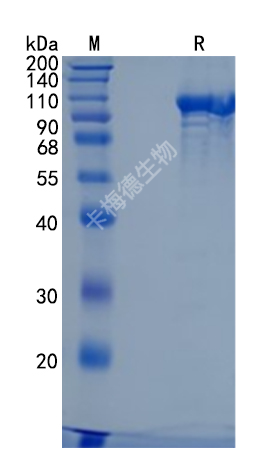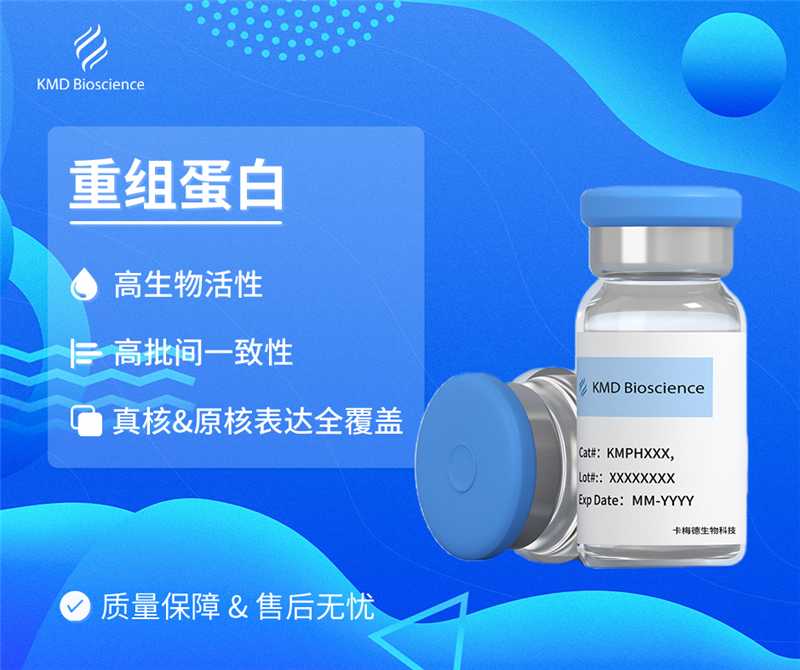| Catalog Number | KRP419 |
| Alias | 自旋素, Autotaxin , EC 3.1.4.39, EC 3.1.4.4, Ectonucleotide pyrophosphatase/phosphodiesterase family member 2, E-NPP 2, Extracellular lysophospholipase D, LysoPLD, ATX, PDNP2, Autotaxin |
| Size | 20ug, 50ug, 100ug, 200ug, 1mg |
| Product Description | Human ENPP2(49-863 aa) |
| Molecular Name | ENPP2 |
| Product Introduction | 自旋素调节细胞外磷脂代谢,影响细胞迁移和增殖。。 |
| Molecular Weight | 99&103 kDa |
| Expression System | HEK293F Cells |
| Species | Human |
| Concentration | 联系销售经理获得最新批次的浓度 |
| Purity | ≥90% |
| SDS-PAGE |  |
| Purification | Affinity Purification |
| Uniprot ID | Q13822 |
| Storage Condition | Store the product under sterile conditions after opening at -80℃ for 12 months. Store the lyophilized powder at -20℃. Avoid repeated freeze-thaw cycles. |
| Formulation | Supplied in PBS |
| Shipping Condition | This product is shipped on ice packs or dry ice. |
| Background | Secreted lysophospholipase D that hydrolyzes lysophospholipids to produce the signaling molecule lysophosphatidic acid (LPA) in extracellular fluids (PubMed:12354767, PubMed:14500380, PubMed:15769751, PubMed:26371182, PubMed:27754931). Its major substrate is lysophosphatidylcholine (PubMed:12176993, PubMed:14500380, PubMed:27754931). Can also act on sphingosylphosphorylcholine producing sphingosine-1-phosphate, a modulator of cell motility (PubMed:14500380). Can hydrolyze, in vitro, bis-pNPP, to some extent pNP-TMP, and barely ATP (PubMed:12176993, PubMed:15769751). Involved in several motility-related processes such as angiogenesis and neurite outgrowth. Acts as an angiogenic factor by stimulating migration of smooth muscle cells and microtubule formation (PubMed:11559573). Stimulates migration of melanoma cells, probably via a pertussis toxin-sensitive G protein (PubMed:1733949). May have a role in induction of parturition (PubMed:12176993). Possible involvement in cell proliferation and adipose tissue development (Probable). Required for LPA production in activated platelets, cleaves the sn-1 lysophospholipids to generate sn-1 lysophosphatidic acids containing predominantly 18:2 and 20:4 fatty acids (PubMed:21393252). Shows a preference for the sn-1 to the sn-2 isomer of 1-O-alkyl-sn-glycero-3-phosphocholine (lyso-PAF) (PubMed:21393252). {ECO:0000269|PubMed:11559573, ECO:0000269|PubMed:12176993, ECO:0000269|PubMed:12354767, ECO:0000269|PubMed:14500380, ECO:0000269|PubMed:15769751, ECO:0000269|PubMed:1733949, ECO:0000269|PubMed:21240271, ECO:0000269|PubMed:21393252, ECO:0000269|PubMed:26371182, ECO:0000269|PubMed:27754931, ECO:0000305|PubMed:15700135}. |
| Endotoxin | < 0.1 EU per ug |
| Biological Activity | Measured by its ability to cleave Bis (pNitrophenyl) Phosphate (BPNPP). The specific activity is >8,000 pmol/min/μg, as measured under the described conditions. |
| Product Declaration | 该产品仅供科研使用,不可直接用于人体或注射。 |












 0
0
